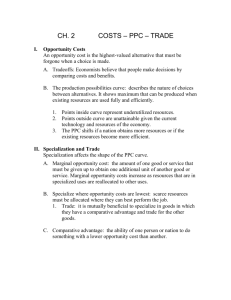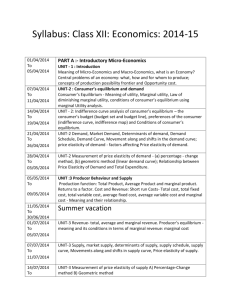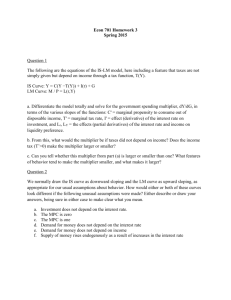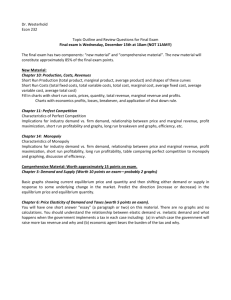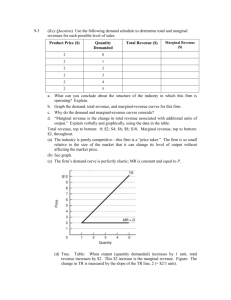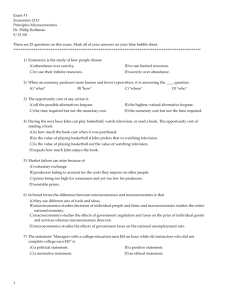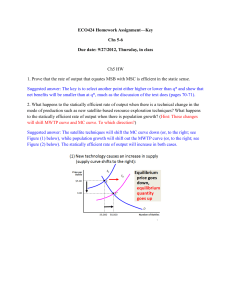CBSE Sample Question Paper - Kendriya Vidyalaya No.1 Salt Lake
advertisement
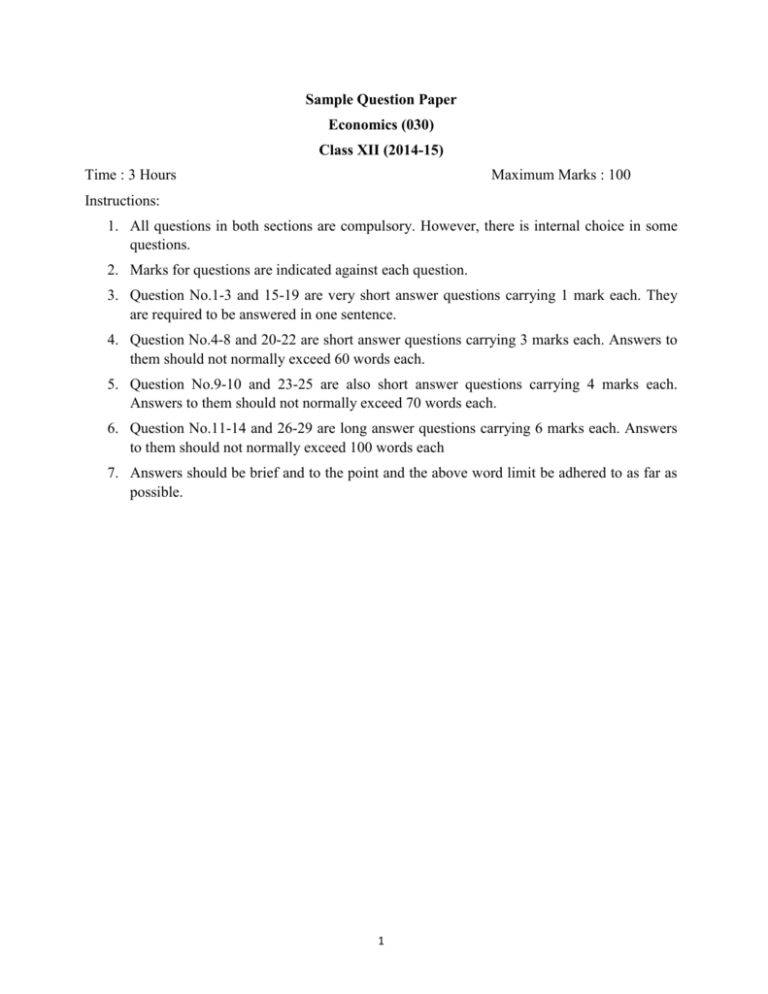
Sample Question Paper Economics (030) Class XII (2014-15) Time : 3 Hours Maximum Marks : 100 Instructions: 1. All questions in both sections are compulsory. However, there is internal choice in some questions. 2. Marks for questions are indicated against each question. 3. Question No.1-3 and 15-19 are very short answer questions carrying 1 mark each. They are required to be answered in one sentence. 4. Question No.4-8 and 20-22 are short answer questions carrying 3 marks each. Answers to them should not normally exceed 60 words each. 5. Question No.9-10 and 23-25 are also short answer questions carrying 4 marks each. Answers to them should not normally exceed 70 words each. 6. Question No.11-14 and 26-29 are long answer questions carrying 6 marks each. Answers to them should not normally exceed 100 words each 7. Answers should be brief and to the point and the above word limit be adhered to as far as possible. 1 Section A: Microeconomics 1. The total cost at 5 units of output is Rs 30. The fixed cost is Rs 5. The average variable cost at 5 units of output is: (1) a) Rs 25 b) Rs 6 c) Rs 5 d) Re 1 2. What policy initiatives can the government undertake to increase the demand of milk in the country? Mention any one. (1) 3. Which of the shaded area in the diagrams below represent total utility? (a) (b) (c) (1) (d) For blind candidates: What does the area under the marginal utility curve depict? a) Average Utility b) Total Utility c) Indifference Curve d) Consumer equilibrium 4. Using a diagram explain what will happen to the PPC of Bihar if the river Kosi causes widespread floods? (3) For blind candidates: State two assumptions of a PPC. Explain what will happen to the PPC of the Bihar if the river Kosi causes widespread floods. 5. State the central problems of an economy. 2 (3) 6. State whether the following statements are True or False. Justify your answer. (3) a) Average product rises only where marginal product rises. b) Total cost rises only when marginal cost rises. 7. Explain the effects of a 'price ceiling'. (3) OR Explain the effects of a ‘price floor’. 8. Explain the implications of freedom of entry and exit of firms under perfect competition. (3) 9. A good is an 'inferior' good for one and at the same time 'normal 'good for another consumer. Do you agree? Explain with the help of an example. (4) 10. Explain why an indifference curve is convex to the origin? (4) OR A consumer consumes two goods X and Y. What will happen if MUx/Px is greater than MUy/Py? 11. Explain the condition of equilibrium of a firm based on marginal cost and marginal revenue. (6) 12. What is meant by change in supply and change in quantity supplied? (6) 13. The following headline appeared in the Hindustan Times on 2 August 2014: (6) "Crop damaged in Himachal sent tomato prices roaring in Delhi." Use a diagram and economic theory to analyse the statement. OR On 19 December 2013, the following news item was printed in the Economic Times: 3 Households in Southern India prefer to eat oranges for breakfast as banana plantations in Kerala have been destroyed and price of apples and grapes have also risen. Use a diagram and economic theory to analyse the impact of the rise in price of apples and grapes on the market of oranges. For blind candidates: The following headline appeared in the Hindustan Times on 2 August 2014: “Crop damaged in Himachal sent tomato prices roaring in Delhi." Analyse the statement based on economics theories. OR On 19 December 2013, the following news item was printed in the Economic Times: Households in Southern India prefer to eat oranges for breakfast as banana plantations in Kerala have been destroyed and prices of apples and grapes have also risen. Analyse the impact of the rise in price of apples and grapes on the market of oranges. 14. A consumer consumes only two goods. Explain the conditions that need to be satisfied for the consumer to be in equilibrium under indifference curve analysis. (6) Section B: Macroeconomics 15. Read the following dialogue between two people Sita : I want 1kg of potatoes Rani: What will you give in exchange? Sita : I can give you 2 litres of milk in return for the potatoes. Rani: I don't need milk. I want a pair of shoe Which of the following problem is being faced by Sita and Rani in their exchange process? 4 (1) a) Lack of double coincidence of wants b) Absence of common units of value c) Lack of store of value d) Lack of standard of deferred payment 16. What is repo rate? (1) 17. Which of the following is a characteristic of a good? (1) a) Intangible b) Can be stored c) Production and consumption must happen simultaneously d) Cannot be transferred 18. The government budget has a revenue deficit. This gets financed by: (1) A. Borrowing B. Disinvestment C. Tax revenue D. Indirect taxes a) A and D b) C and D c) A and B d) C and D 19. Which of the following statement is not true for fiscal deficit? (1) A fiscal deficit: a) represents the borrowing of the government. b) is the difference between total expenditure and total receipts of the government c) is the difference between total expenditure and total receipts other than borrowing d) increases the future liability of the government 20. What is the role of a Central Bank in the following exchange rate? a) Fixed exchange 5 (3) b) Floating exchange c) Managed floating 21. In an economy the autonomous investment is 100 and the consumption is C=80+0.4Y. Is the economy in equilibrium at an income level 400? Justify your answer. (3) OR In an economy the autonomous investment is 60 and the marginal propensity to consume is 0.8. If the equilibrium level of income is 400, then the autonomous consumption is 30. True or False? Justify your answer. 22. In an economy planned saving is greater than planned investment. Explain how the economy achieves equilibrium level of national income. (3) 23. Only one Product X is produced in the country. Its output during the year 2012 and 2013 was 100 units and 110 units respectively. The market price of the product during the year was Rs 50 and Rs 55 per unit respectively. Calculate the percentage change in real GDP and nominal GDP in year 2013 using 2012 as the base year. (4) 24. What is meant by “balance of payment” account? Distinguish between the "balance on current account" and "balance of trade" account. In which account would remittances from family members from abroad be accounted? (4) 25. State the various components of the Income Method that are used to calculate national income. (4) OR State any four precautions that need to be kept in mind when using the value added method for calculating national income. 26. In the government of India's budget for the year 2013-14, the Finance Minister (6) proposed to raise the excise duty on cigarettes. He also proposed to increase income tax on individual earning more than Rs. one crore per annum. Identify and explain the types of taxes proposed by the Finance Minister. Was the objective only to earn revenue for the government? What possible welfare objectives could the Government be considering? 27. Draw a straight line consumption curve. From it derive the saving curve. Explain the process of derivation on the diagram, show: (6) a) The income level at which APC=1 6 b) The income level at which APS is negative For blind candidates: Explain the process of working of the 'investment multiplier' with the help of a numerical example. 28. a) What is meant by Cash reserve ratio? How does it increase the money supply in the economy? (3+3) b) What is meant by Open market operation? How does it reduce the money supply in the economy? 29. Find (a) National Income and (b) Gross National Disposable Income. Rs Crore i. Net current transfer from abroad 5 ii. Private final consumption expenditure 200 iii. Subsidies 20 iv. Net domestic fixed capital formation 40 v. Net factor income to abroad 10 vi. Government final consumption expenditure 50 vii. Change in stock (-)10 viii. Net imports (-)20 ix. Consumption of fixed capital 30 x. Indirect tax 60 xi. Exports 100 OR Find (a) Private Income and (b) National Income. i. Personal disposable income 350 ii. Income from property and entrepreneurship accruing to the government administrative departments 50 7 (6) iii. Savings of non-departmental enterprises 25 iv. Direct personal tax 10 v. Net factor income from abroad (-)5 vi. Indirect taxes 15 vii. Current transfers to the rest of the world 20 viii. Savings of private corporate sector 25 ix. Corporation tax 15 x. Current transfers from government 30 8
